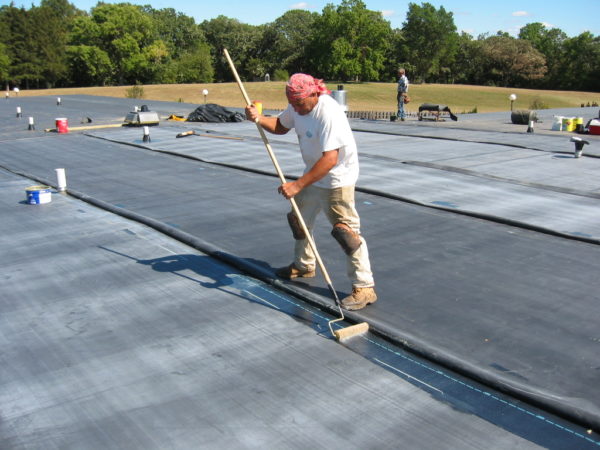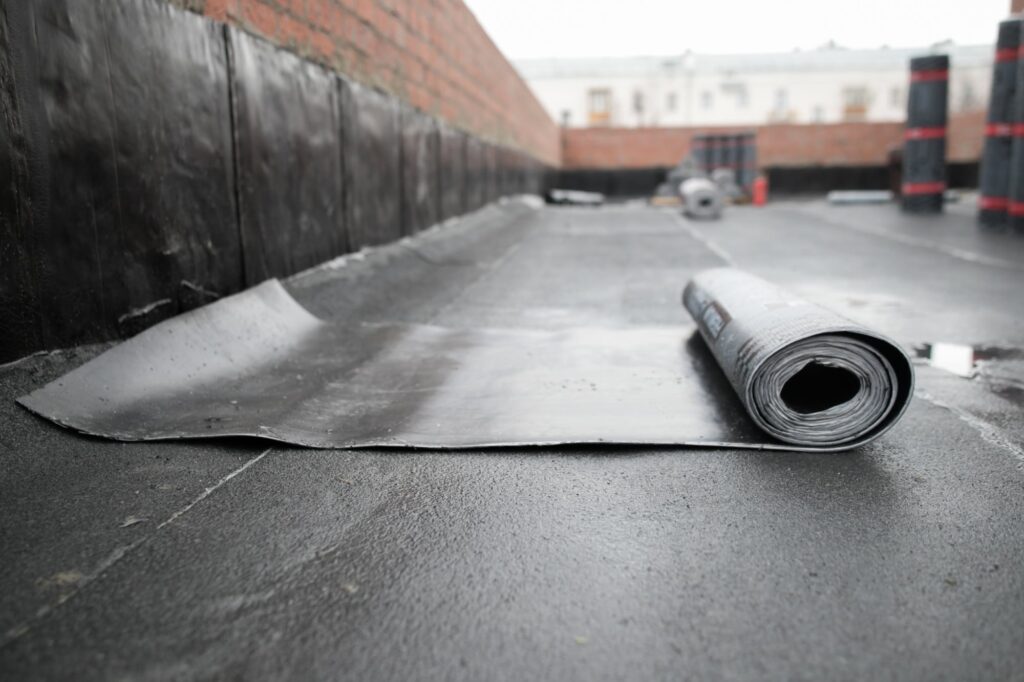How to Install EPDM Roofing: A Complete Guide

EPDM roofing is an option for low-slope or flat roofs, as it offers many benefits, including durability, flexibility, resistance to weather , ease of installation, and low maintenance. EPDM stands for ethylene propylene diene monomer — the technical name for this synthetic rubber membrane perfect for restoring flat roofs. EPDM roofing has a proven track record and can withstand harsh conditions such as extreme heat, cold, rain, snow, hail, and fire.
Installing EPDM roofing is not a difficult task, but it requires some tools and materials, as well as some basic knowledge and skills. In this article, you’ll find a step-by-step guide on how to install EPDM roofing correctly and safely. We will also explain how professional roofing contractors — like Silicoat Roofing — can help you with your EPDM roofing project and ensure a successful and long-lasting installation.
Here at Silicoat Roofing, we offer EPDM roofing repair in Detroit and the surrounding areas, and we’re here to help if your commercial roof needs repairs beyond what you can handle as a do-it-yourselfer. Don’t hesitate to reach out to us if you need a hand!
What is EPDM Roofing, and Why Should You Choose It?
EPDM roofing is a type of synthetic rubber membrane that is widely used for low-slope or flat roofs. It comes in rolls of various sizes and thicknesses, ranging from 45 mils to 90 mils. The membrane can be black or white, depending on your preference and needs. The membrane can be installed using different methods, such as fully adhered, mechanically fastened, or ballasted.
EPDM roofing has many advantages over other types of roofing materials, such as:
- Durability: An EPDM rubber roof can handle temperature fluctuations, thermal shock. It is less prone to cracks, rot, and deterioration over time than many other roofing solutions, making it an excellent long-term roof repair option.
- Flexibility: EPDM roofing can conform to any shape or contour of the roof, and it’s easy to fit it around chimneys, pipes, skylights, and gutters. This flexibility also ensures the material won’t crack from extreme dryness or heat.
- Resistance: EPDM roofing is resistant to water, fire, wind, hail, snow, ice, mold, mildew, algae, and insects.
- Ease of installation: EPDM roofing is easy to install with minimal tools and equipment. It does not require any special skills or training. It can also be installed in any weather condition and season.
- Low maintenance: EPDM roofing requires little or no maintenance once installed. It does not need any coatings, sealants, or paints to protect it from the elements. It only needs periodic inspection and cleaning to remove any dirt or debris.
How to Prepare the Roof Surface for EPDM Roofing Installation
Before we explore how to install EPDM roofing, it’s important to prepare the roof’s surface. The roof surface needs to be clean, dry, and free of debris, nails, screws, or other obstructions that could damage the membrane or prevent the adhesives from bonding properly.
If the roof has existing roofing material, such as asphalt or shingles, it may need to be removed or covered with a suitable substrate, such as plywood or gypsum board. Any damaged or rotten roof deck areas may need to be repaired with new materials.
You must also inspect the roof surface for any penetrations or transitions that may need flashing, such as vents, pipes, skylights, or chimneys. These areas need to be measured and marked, and you’ll need to determine the best way to install the flashing around them.
Measure the position of the membrane on the roof surface and mark it using a tape measure and a chalk line. Add some extra length to account for overhang and trimming. If you will be using more than one piece of membrane, you’ll need to overlap them by about 3 inches and align them in the same direction.
How to Apply the Adhesive for EPDM Roofing Installation
After preparing the roof surface for EPDM roofing installation, the adhesive needs to be applied for EPDM roofing installation. The adhesive is a special glue designed to bond the EPDM membrane to the roof substrate. It is similar to contact cement and comes in cans or buckets. It needs to be applied to both the roof surface and the back of the membrane using a roller or a brush. Follow the manufacturer’s instructions for the type and amount of adhesive to use. The glue needs to dry enough to become tacky before laying down the membrane.
Fold the membrane back halfway, then apply the adhesive to both surfaces. Once the adhesive is tacky, carefully roll the membrane back and press it firmly onto the roof substrate. Repeat this process for the other half of the membrane. When you’re finished, use a broom or a squeegee to smooth out any bubbles or wrinkles.
How to Seal the Seams for EPDM Roofing Installation
If you use more than one piece of membrane, the seams between them need to be sealed for EPDM roofing installation using EPDM seam tape and primer. The primer is a liquid that is used to prepare the surface of the membrane before applying the seam tape. It comes in cans or bottles with applicators. Apply it along the edge of one piece of membrane and let it dry completely.
Seam tape is a double-sided tape used to seal the seams. It comes in rolls of various widths and lengths and needs to be applied along the same edge. Then, the paper backing needs to be removed. Overlap the other piece of membrane by about 3 inches and press it onto the seam tape. Use a roller or a squeegee to smooth out any bubbles or wrinkles along the seam.
How to Install the Flashing for EPDM Roofing Installation
To finish your EPDM roofing installation, install the flashing. The flashing is a flexible material used to cover any penetrations or transitions on the roof, such as vents, pipes, skylights, chimneys, walls, or edges. It comes in sheets or rolls of various sizes and shapes. Cut and fit it around penetrations and transitions, then apply primer and adhesive or seam tape to both the flashing and the roof surface. Press the flashing onto the roof surface firmly, and seal any gaps or corners with EPDM lap sealant.
How Professional Roofing Contractors Can Help You with EPDM Roofing in Detroit
Installing EPDM roofing is not a difficult task, but it requires some tools and materials, as well as some basic knowledge and skills. If you are not confident or experienced in installing EPDM roofing, you may want to hire a professional contractor to help you with your Detroit EPDM roofing project and ensure a successful and long-lasting installation.
A professional roofing contractor can provide you with many benefits, such as:
- Expertise: A professional roofing contractor has knowledge and experience in installing EPDM roofing on commercial buildings. They know how to handle any challenges or issues that may arise during the installation process. They can also advise you on the best type and size of EPDM membrane for your roof, as well as the best method and technique of installation.
- Quality: Reputable roofing contractors will guarantee the quality and performance of your EPDM roof. They use only high-quality materials and products that are certified and tested for EPDM roofing. They also follow industry standards and best practices for EPDM roofing installation. They can also provide you with a certificate of completion for your EPDM roof.
- Safety: A professional roofing contractor prioritizes the safety and security of your property and personnel during the installation process. They have the proper tools and equipment that are safe and suitable for roofing work. They also have proper training and insurance covering accidents or damages that may occur during installation.
- Convenience: A professional roofing contractor can save you time and hassle by handling all aspects of your EPDM roofing project. They can handle everything, including planning, preparation, delivery, installation, inspection, cleanup, and disposal. They can also work around your schedule and budget and complete your project within the agreed timeframe and cost.
Contact Us Today for EPDM Roofing in Detroit
If you decide you’d rather hire a professional after learning how to install EPDM roofing, we’re here to help. At Silicoat Roofing, we are experts in installing EPDM roofing on low-slope and flat roofs. We have been handling Detroit’s industrial and commercial roofing needs for over 20 years and have the experience, expertise, and equipment to handle any EPDM roofing project.
We use only high-quality materials and products that are certified and tested for EPDM roofing. We even stand behind our services with a 20-year guarantee, and you can count on us to provide excellent customer service and satisfaction. Give us a call today!

